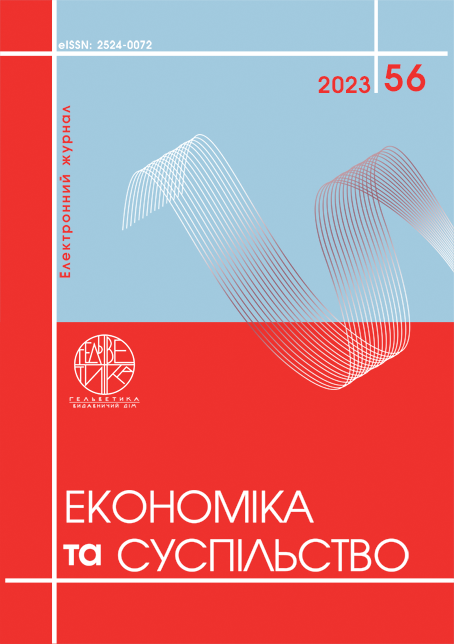MARKETING OF PERSONNEL WITH SPECIAL NEEDS AS AN INNOVATIVE APPROACH TO HUMAN RESOURCE MANAGEMENT
Abstract
The issue of paying attention to persons with disabilities, special needs, and the presence of disabilities, their economic contribution to the development of the state, region, and territory is becoming more relevant and more meticulous in the details of the practical implementation of many theoretical and currently abstract goals. This article defines, first of all, the regulatory guidelines adopted at the end of the 20th and the beginning of the 21st century in the countries of the European Union and other developed countries regarding overcoming discrimination of various degrees regarding the access of people with disabilities to social benefits, observance of their rights and freedoms for work, recreation , equal pay, physical access to available public services, public discussions, etc. It is further emphasized that the number of persons with disabilities is increasing due to the spread of man-made and humanitarian disasters of an anthropogenic nature, which necessitates the understanding that these persons will eventually become an integral part of society and must bring additional income, be able to support themselves and reduce the social burden. Therefore, innovative approaches to the marketing of personnel with disabilities are proposed. The first approach is to use the traditional formula for determining the number of personnel in the company (at the enterprise) with a modification of the issues of the Washington group of partners of ESNO regarding the measurement of the indicators of the employee's disability level and the formation of the "smart space" of his workplace. The second innovative direction is to conduct an audit of the workplaces of the entire company and determine which work can be optimally performed by persons with disabilities. Take into account in the model the full or partial replacement of existing personnel by persons with disabilities, determine the losses and the necessary measures of the company regarding the arrangement of workplaces, territory and premises for the needs of persons with disabilities. The third innovative direction is the introduction of a person with a disability into the work team in order to adapt the team to the presence of such people, determine their needs on the spot, take into account the losses of the company to rework all functional components of the workplace to the needs of such employees (job instructions, workplaces, sanitary areas, premises and the territory in general, staff relations, the presence of an accompanying person with an employee with a disability, etc.). These directions do not pretend to fully cover the growing problem of the number of people with disabilities in the workplace, but at the methodological and practical levels prepare society and individual companies, enterprises, territories, communities to overcome barriers and discrimination of such workers, respect and restore their rights and freedoms regarding employment, professional realization and self-care.
References
Всесвітня організація охорони здоров’я (ВООЗ) і Світовий банк, Всесвітня доповідь щодо питань осіб з інвалідністю, Женева, ВООЗ, 2011 рік, Розділ 2. URL : http://www.who.int/disabilities/world_report/2011/report.pdf (дата звернення 10.03.2023).
Charter of fundamental rights of the European Union (2000/C 364/01). URL : https://www.europarl.europa.eu/charter/pdf/text_en.pdf (дата звернення 12.03.2023).
European Disability Strategy 2010-2020: A Renewed Commitment to a Barrier-Free Europe. Brussels, 2010. 12 p. URL : https://eur-lex.europa.eu/LexUriServ/LexUriServ.do?uri=COM:2010:0636:FIN:en:PDF (дата звернення 30.05.2023)
Конвенція про права осіб з інвалідністю: Документ № 995_g71 від 13.12.2006 (чинна редакція від 19.06.2023). URL : https://zakon.rada.gov.ua/laws/show/995_g71#Text (дата звернення 20.06.2023).
Посібник з інклюзивності осіб з інвалідністю в операціях з надання гуманітарної допомоги, що фінансуються ЄС. Брюсель. Лютий 2019. 38 с. URL : https://ec.europa.eu/echo/files/policies/disability_inclusion/doc_echo_og_inclusion_ukr_liens_bd_ua.pdf (дата звернення 01.06.2023).
Vsesvitnya orhanizatsiya okhorony zdorovʺya (VOOZ) i Svitovyy bank, Vsesvitnya dopovidʹ shchodo pytanʹ osib z invalidnistyu, Zheneva [World Health Organization (WHO) and World Bank, World Report on Persons with Disabilities], VOOZ, 2011 rik, Rozdil 2. URL : http://www.who.int/disabilities/world_report/2011/report.pdf (data zvernennya 10.03.2023).
Charter of fundamental rights of the European Union (2000/C 364/01). URL : https://www.europarl.europa.eu/charter/pdf/text_en.pdf (data zvernennya 12.03.2023).
European Disability Strategy 2010-2020: A Renewed Commitment to a Barrier-Free Europe. Brussels, 2010. 12 p. URL : https://eur-lex.europa.eu/LexUriServ/LexUriServ.do?uri=COM:2010:0636:FIN:en:PDF (data zvernennya 30.05.2023).
Konventsiya pro prava osib z invalidnistyu [Convention on the Rights of Persons with Disabilities]: Dokument № 995_g71 vid 13.12.2006 (chynna redaktsiya vid 19.06.2023). URL : https://zakon.rada.gov.ua/laws/show/995_g71#Text (data zvernennya 20.06.2023).
Posibnyk z inklyuzyvnosti osib z invalidnistyu v operatsiyakh z nadannya humanitarnoyi dopomohy, shcho finansuyutʹsya YES [Handbook on inclusiveness of persons with disabilities in EU-funded humanitarian aid operations]. Bryuselʹ. Lyutyy 2019. 38 s. URL : https://ec.europa.eu/echo/files/policies/disability_inclusion/doc_echo_og_inclusion_ukr_liens_bd_ua.pdf (data zvernennya 01.06.2023).

This work is licensed under a Creative Commons Attribution 4.0 International License.


